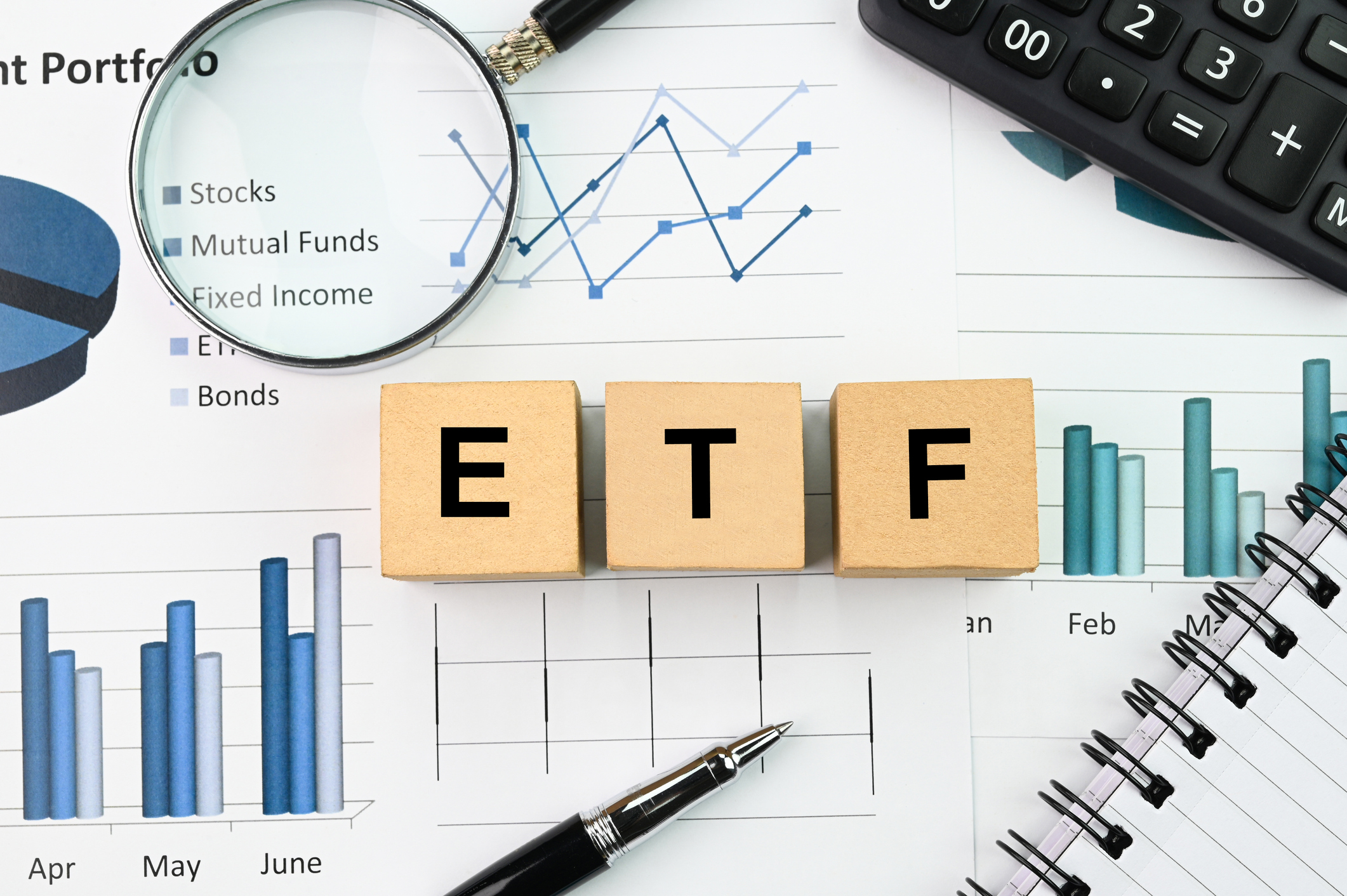What is an ETF? Everything you need to know about exchange-traded funds
Many investors use ETFs, or exchange-traded funds, as part of a passive investment strategy. But what is an ETF?


These are some of the most popular funds that investors use to execute their investing strategy, but what are ETFs?
As the name suggests, exchange-traded funds or ETFs are funds that are bought and sold on stock exchanges. As such, their prices change in real time like a stock, rather than at the end of each day, and investors can buy them at their current price at any time during stock market opening times.
ETFs come in two forms: active and passive.
MoneyWeek
Subscribe to MoneyWeek today and get your first six magazine issues absolutely FREE

Sign up to Money Morning
Don't miss the latest investment and personal finances news, market analysis, plus money-saving tips with our free twice-daily newsletter
Don't miss the latest investment and personal finances news, market analysis, plus money-saving tips with our free twice-daily newsletter
Passive ETFs track the performance of a specific sector by investing in a benchmark index. They don’t attempt to beat their benchmark, but to accurately replicate its returns. These are, historically, the most common form of ETF, though active ETFs are increasingly popular.
“The debate around ETFs vs mutual funds has historically been a proxy for the active vs passive debate,” Tom Bailey, Head of ETF Research at HANetf, tells MoneyWeek. This, however, has been changed by the rise of active ETFs.
Active (or actively managed) ETFs have a portfolio manager that adjusts the allocation of securities within the fund to try to beat the performance of the benchmark index (if there is one – some active ETFs aren’t based on an index at all).
ETFs usually track the price of stocks and shares, but they can theoretically track any asset class. ETFs (or similar products like ETCs) exist for bonds, commodities and currencies, while some (known as multi-asset ETFs) invest in a mixture of asset classes.
How do ETFs work?
There is another way to categorise ETFs, which has a direct impact on how they function: physical and synthetic.
Physical ETFs own the securities they track. For example, a physical FTSE 100 tracker would own all the shares in the FTSE 100 in the same proportion as in the underlying index.
Synthetic ETFs replicate the returns of the securities or market they track using derivatives. Synthetic ETFs still have to be backed by collateral, but the use of derivatives introduces counterparty risk. That is, the danger – however small – that the investment bank which underwrites the derivative might be unable to pay out.
Either way, ETFs are priced in line with the total value of all their holdings and cash (‘net asset value’ or NAV).
While, in theory, an ETF’s price could diverge from its NAV if investors buy or sell it more than the sum of its individual holdings, a mechanism exists that keeps its price aligned with the assets it tracks. In simple terms, authorised partners create or remove new ETF units when its price diverges from NAV, quickly correcting any discrepancy.
This is in contrast to other funds such as investment trusts, which have a fixed number of shares from inception and can therefore diverge more widely from their NAV.
Pros and cons of ETFs
There are various reasons why ETFs are so popular among investors. These include:
- Diversification: thematic ETFs offer investors a convenient way for investors to gain exposure to a sector or theme whilst diversifying and rebalancing their investment across multiple securities;
- Tax efficiency: ETFs can be held in a stocks and shares ISA, protecting your investment from the taxman;
- Low costs: ETFs, especially passive ones, tend to have relatively low fees compared to other types of fund;
- Transparency: ETFs publish their holdings daily, while mutual funds and close-ended funds aren’t required to and tend only to publish holdings quarterly.
Also, as Bailey points out, the fact that ETFs are traded on exchanges in real time offers advantages over mutual funds. It “provides greater flexibility and real-time pricing”, he says, adding that end-of-day pricing for mutual funds and the need for orders to be placed in advance “seems archaic” in an on-demand world.
Investors should, however, consider the potential drawbacks of ETFS:
- Passive ETFs will never outperform their benchmarks over the long term. Active ETFs might outperform their benchmark, but they can also underperform it.
- ETFs are designed to achieve a specific investment objective over the long term. They aren’t suitable for short-term trading, as over shorter time frames their performance can vary from their benchmark.
ETFs and ETCs: what’s the difference?
An exchange-traded commodity (ETC) works very similarly to an ETF, but tracks the price of a specific commodity.
This is subtly different from a commodity-focused ETF, which will generally invest in shares of companies that are directly exposed to a commodity (such as copper miners) in order to reflect its price movements. While they might produce similar returns, the underlying mechanism is different.
In all other respects, however, ETCs are very similar to ETFs. They offer everyday investors access to commodity investing without having to use complex instruments such as futures or options.
How to invest in ETFs
One of the best aspects of ETFs is their convenience. They can be bought and held in a stocks and shares ISA, like a stock, so if you don’t already have one, opening one of these is the best first step towards ETF investing.
Before buying, though, consider the type of ETF you want to buy, and research the various options available. There are usually multiple ETFs available for any given sector or asset class, so compare options from different providers to assess factors such as fees and the ETF’s strategy and holdings before deciding which to invest in.
Examples of ETFs
If you’re new to ETF investing, a good place to start might be with a passive fund that tracks a major index.
Some examples include:
- The Vanguard S&P 500 UCITS ETF (LSE:VUSA), which tracks the S&P 500;
- The Invesco FTSE 250 UCITS ETF (LSE:S250), which tracks the FTSE 250;
- The iShares NASDAQ 100 UCITS ETF (LSE:CNDX), which tracks the Nasdaq 100.
More confident investors might want to add ETFs to their portfolio in order to gain exposure to a specific sector or asset class. Some examples of ETFs that could be used in this way are:
- The WisdomTree Artificial Intelligence UCITS ETF (LSE:INTL), a passive fund that tracks the NASDAQ CTA Artificial Intelligence Index;
- The L&G ESG GBP Corporate Bond UCITS ETF (LSE:GBPC), which offers exposure to the sterling-dominated investment grade corporate bond market by tracking the J.P. Morgan GCI ESG Investment Grade GBP Custom Maturity Index;
- The Royal Mint Responsibly Sourced Physical Gold ETC (LSE:RMAU), which tracks the gold spot price. As this is a physical ETC issued by the Royal Mint, holders can exchange shares of the ETC for responsibly-sourced gold coins or bars stored by the Mint.
Can I buy US ETFs from the UK?
Investors based in the UK might want to use ETFs to track the performance of US companies or indices. US regulations mean that UK-based investors cannot buy US-listed funds, but there is a workaround, however, in the form of the UCITS legislation. UCITS (Undertakings for Collecting Investment in Transferable Securities) is a regulatory framework that allows European investors to buy US-listed funds, as long as they carry the UCITS designation.
To find out more about ETFs, subscribe to MoneyWeek magazine.
Get the latest financial news, insights and expert analysis from our award-winning MoneyWeek team, to help you understand what really matters when it comes to your finances.

Dan is a financial journalist who, prior to joining MoneyWeek, spent five years writing for OPTO, an investment magazine focused on growth and technology stocks, ETFs and thematic investing.
Before becoming a writer, Dan spent six years working in talent acquisition in the tech sector, including for credit scoring start-up ClearScore where he first developed an interest in personal finance.
Dan studied Social Anthropology and Management at Sidney Sussex College and the Judge Business School, Cambridge University. Outside finance, he also enjoys travel writing, and has edited two published travel books.
-
 Boost for over 100,000 families on Child Benefit as new HMRC payment system rolled out
Boost for over 100,000 families on Child Benefit as new HMRC payment system rolled outThousands of households will no longer have to pay the dreaded High Income Child Benefit Charge through self-assessment
-
 Are you being haunted by the ghost of Christmas past? How festive cutbacks could boost your long-term wealth
Are you being haunted by the ghost of Christmas past? How festive cutbacks could boost your long-term wealthThe average family spends around £1,000 over the Christmas season. Here’s how much you could have gained if you had invested some of the money instead.
-
 The top stocks of 2025 - did you pick a winner?
The top stocks of 2025 - did you pick a winner?As a chaotic year in the stock market draws to a close, we review which stocks were investors’ top picks for 2025
-
 Canada will be a winner in this new era of deglobalisation and populism
Canada will be a winner in this new era of deglobalisation and populismGreg Eckel, portfolio manager at Canadian General Investments, selects three Canadian stocks
-
 Best-performing stocks in the S&P 500
Best-performing stocks in the S&P 500We take a look at the best-performing stocks in the US equity market. Are there opportunities outside of Big Tech?
-
 What is Vix – the fear index?
What is Vix – the fear index?What is Vix? We explain how the fear index could guide your investment decisions.
-
 The case for dividend growth stocks
The case for dividend growth stocksMany investors focus on yield alone when looking for income, that’s a mistake says Rupert Hargreaves. It’s the potential for dividend growth that really matters.
-
 Halifax: House price slump continues as prices slide for the sixth consecutive month
Halifax: House price slump continues as prices slide for the sixth consecutive monthUK house prices fell again in September as buyers returned, but the slowdown was not as fast as anticipated, latest Halifax data shows. Where are house prices falling the most?
-
 Rents hit a record high - but is the opportunity for buy-to-let investors still strong?
Rents hit a record high - but is the opportunity for buy-to-let investors still strong?UK rent prices have hit a record high with the average hitting over £1,200 a month says Rightmove. Are there still opportunities in buy-to-let?
-
 Pension savers turn to gold investments
Pension savers turn to gold investmentsInvestors are racing to buy gold to protect their pensions from a stock market correction and high inflation, experts say